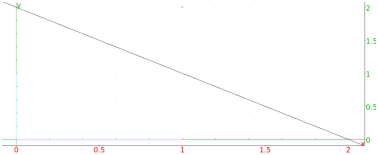


13.17.6 The polar reciprocal: reciprocation
The reciprocation command finds poles and polars.
-
reciprocation takes two arguments:
-
C, a circle.
- L, a list of points and lines.
- reciprocation(C,L) returns the list formed by
replaced each point or line in L by its polar or pole with respect
to the circle C.
Example.
Input:
reciprocation(circle(0,1),[point((1+i)/2),line(1,-1+i)])
Output:










